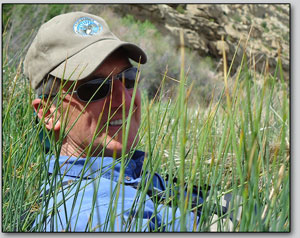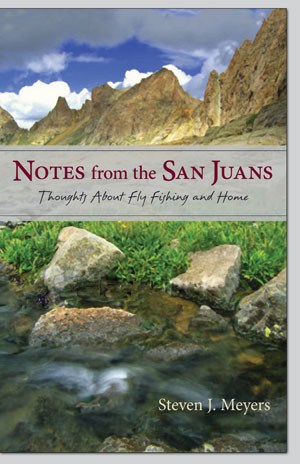 |
|
Steve Meyers tries his luck on the San Juan River./Photo by Roger Hirst
|
Hooked on the San Juans
Reflections of love, life, ones that got away and ones that didn’t
by Missy Votel
When it comes to flyfishing, most people wouldn’t know a midge from a dry fly. An Olive Sparkle Dun may as well be something you order at a martini bar. In fact, it may be safe to say that for some, present company included, knowledge of the sport doesn’t extend much further than a brief dalliance in the 1990s with Brad Pitt and “A River Runs Through It.”
Fortunately, local writer and flyfisherman extraordinaire (a sketch of him has appeared in the Sage catalog) Steven Meyers merely uses fishing as a segue to cover topics as varied and rich as the colors of the speckled trout he constantly seeks. Not only is Meyers a veteran guide and fisherman, he is an artist, photographer, professor of creative writing at Fort Lewis College and all-around mountain man. His stories, while swirling around his abiding love for flyfishing, also center on the mountains, streams and people that make up the San Juans, from the high-alpine Annabelle Lake to the gold medal fishery below Navajo Dam. In other words, topics to which practically all of us who chose this areas as our home can relate.
And for those who like to read about the San Juans when not frolicking in them, Meyers has recently re-released two of his long-out-of-print cult classics, Notes from the San Juans: Thoughts About Fly Fishing and Home and San Juan River Chronicle: Personal Remembrances of One of America’s Best-known Trout Streams through Portland, Ore.-based WestWinds Press.
|
-Tues., Oct. 1, 6:30 p.m., Maria's Bookshop -Sat., Oct. 5, 1-3 p.m., Duranglers |
“They’re more about childhood, family,” said Meyers, who spent 12 years living in Silverton before relocating to Durango in 1987, “... about searching for a home and a discussion of this notion of home.”
That search is one Meyers knows well. Born outside of New York City, his father taught him to flyfish as a young boy in northern New Jersey in the 1950s. He carried that love of the outdoors with him into adulthood. However, his father, a decorated world War II veteran, suddenly disappeared while Meyers was in college, a story he details in the prologue of Notes from the San Juans. Trying to come to grips with the “unfathomable” news, Meyers leaves his post-graduation stint as a banker in New York City and heads to Chicago to earn a graduate degree in fine art. From there, he heads even farther West, to take a job with a small publishing company in Denver. In 1976, the company relocates to Silverton, and when it pulls up stakes to return to Denver, Meyers chooses to stay.
“I really had no idea what I was getting into,” he recalled in an interview Monday. “It was my attempt to make sense of things and to find a life my father would have chosen for himself.”
The choice to stay was one Meyers had made, perhaps subconsciously, years earlier during a roadtrip between Chicago and Utah. While studying the map on his way back east, he stumbled upon an “orange dotted line along the highway between Durango and Ouray” by chance. Or was it destiny?
“These mountains were not the same as I had seen before,” he writes of his first foray into the San Juans. “I sat there not quite knowing what I was feeling, but firmly believing someday I would return. That feeling was one of primal discovery. I had found without even knowing I had been looking, my home.”
Meyers settled into the small mountain hamlet, where he and his first wife became friends with the quirky and colorful locals. It is here that Notes From the San Juans takes off, offering profiles of the friends he made, including deep-ecologist Dolores LaChapelle, who taught him to backcountry ski, and vignettes of life at 10,000 feet, from the birth of his son to love lost.
He also tries to tackle that eternal question outsiders often ask: how, and more importantly why, do people settle in Silverton? He recalls a joke once told to him by longtime Silvertonian, the late Hollis Holland, who died snowmobiling on Molas Pass last February. Holland, a seasoned member of Search and Rescue and the Silverton Avalanche School, quipped that San Juan County was the world’s largest open-air asylum. “It’s inhabitants, he implied, were all crazy,” Meyers writes. “There was more than a little truth to that.”
In fact, of LaChapelle, whom he considered his best friend and devotes a chapter to in his book, he lovingly jokes, “she was wonderful and brilliant, but crazy as bat sh--.”
Perhaps it’s trying to eek out an existence at close to 10,000 feet that does it to a person. During his tenure in Silverton, in addition to working for the aforementioned publishing company and as a freelance photographer and writer, Meyers held down jobs at the Sunnyside Mine, as a member of a backcountry surveying crew, and as a ski instructor at Purgatory.
Eventually, the rarified, invigorating insanity that was Silverton took a toll. Reeling from the tragic loss of a lover to leukemia, Meyers moved south to start a new chapter. “I’m really, really grateful for the time I spent in Silverton, but it was time to move on and start a new life,” he said.
It was in Durango – where he met his future wife, Debbie, and began teaching at FLC and guiding for Duranglers – that San Juan River Chronicles picks up. The book, originally published in 1994, contains a new introduction, something Meyers said was necessary to reflect the changes of the river over the last 20 years.
“When I first started fishing down there, there was tons of water,” Meyers said. However, drought and dwindling dam releases conspired to change that, as well as the ecology of the river itself. Without the flushing flows of spring run-off, the San Juan’s cobbles became covered in silt, more suitable to larva and other worm-like insects than classic may and caddis flies. However, Meyers credits the New Mexico Department of Game and Fish for working to restore the river’s clarity and helping to bring back the dwindling fly populations.
 |
| Meyers relaxes among the reed grass along the San Juan River. Meyers recently re-released two of his out-of-print collections of essays on 24 years of fishing and life in the San Juans./ Courtesy photo |
Over the years, the river has also seen growth in other species as well, including non-native brown trout, which have since outnumbered the rainbows, and wader-clad homo sapiens, some of whom Meyers writes about. During his decades of guiding, Meyers had the opportunity to take everyone from Fortune 500 CEOs to Supreme Court justices down the river, although he says professional ethics forbid him from naming names.
“Almost any major, powerful political figure has someone in their circle who is addicted to fishing,” said Meyers. “That’s one of the cool things about being a guide. These people get out on the river to get away, and they loosen up and say stuff that they think will go no farther than nowhere, because that’s where they think they are.”
Through all the changes, however, Meyers maintains that the quality of the San Juan’s fishery never suffered. It’s still the same worldclass casting grounds its always been, just different. And while it may be harder to find that secluded spot teeming with hungry trout, it’s still possible, especially on weekdays and during shoulder seasons. You just need to know where to go.
I guess you could say, through it all, Meyers has managed to go with the flow. “Rivers are always changing, going in cycles,” he said.
But one thing that will never change? “After 24 years, this summer I decided I would kind of retire, I think I was ready to hang up my guiding waders,” he said. “I just wanted to fish.”
For more on Steven Meyers, go to www.stevenjmeyers.com or visit him on Facebook.
In this week's issue...
- January 25, 2024
- Bagging it
State plastic bag ban is in full effect, but enforcement varies
- January 26, 2024
- Paper chase
The Sneer is back – and no we’re not talking about Billy Idol’s comeback tour.
- January 11, 2024
- High and dry
New state climate report projects continued warming, declining streamflows

 Steven Meyers, author of Notes from the San Juans: Thoughts About Fly Fishing and Home and San Juan River Chronicle: Personal Remembrances of One of America's Best-known Trout Streams, will be holding two upcoming booksignings and presentations:
Steven Meyers, author of Notes from the San Juans: Thoughts About Fly Fishing and Home and San Juan River Chronicle: Personal Remembrances of One of America's Best-known Trout Streams, will be holding two upcoming booksignings and presentations: